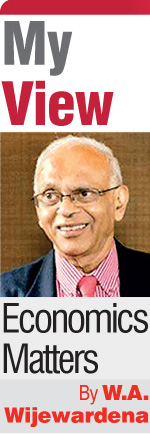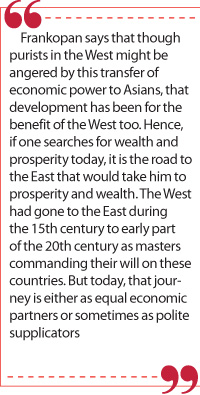Tuesday Mar 04, 2025
Tuesday Mar 04, 2025
Monday, 31 May 2021 00:32 - - {{hitsCtrl.values.hits}}

Historian Peter Frankopan
|
Cover of The New Silk Roads
|
Sri Lanka’s contrasting perception of threat to sovereignty
Two events that took place in Sri Lanka within a space of about 24 months have presented two contrasting results. One was the rejection by Sri Lanka’s Government of the Millennium Challenge Corporation or MCC Grant offered by the US on the ground that it interfered with the sovereignty of the country. The other is the acceptance of the Colombo Port City Development Project being implemented under the leadership of China, also charged by the critics as a betrayal of Sri Lanka’s sovereignty.
If the sovereignty was the issue, China cannot be accepted, while rejecting the US. Therefore, the approach to these issues by the Sri Lankan authorities is puzzling. But anyone who reads Oxford historian Peter Frankopan’s latest book, The New Silk Roads, would not be puzzled by this contrasting choice.
History represented through Silk Roads
The New Silk Roads is a sequel to Frankopan’s first book, The Silk Roads: A New History of the World, published in 2015. The Silk Roads did not present the world history in terms of the popular approach by historians, namely, referring to lives of monarchs or expansion or contraction of empires. Rather, it represented world history in terms of trade, commerce, culture, and religious faiths.
The silk roads started some 2,200 years ago when China opened a corridor to Central Asia and beyond. Through this corridor, trade and commerce took place between China and Europe. The most famous Chinese product that travelled along this route was silk and therefore, the trade route via Central Asia to Europe was known as the Silk Road. If one considers the Silk Road as a symbol of trade and commerce, any trade relation between two or more nations prior to this can also be called a Silk Road. 
Along the Chinese Silk Road spread the most important behavioural patterns of humans, namely, foods, language, faith, knowledge, culture, and craftmanship. Thus, to Frankopan, human history involving all these aspects is a repeat of a silk road. That is the basis of the representation of world history in terms of silk roads in Frankopan’s book, The Silk Roads.
Two global shocks
The New Silk Roads covers the human history in the modern period. It has been written before the world was hit by two shocks, one positive and the other negative. The positive shock was the ousting of Donald Trump from the US Presidency in late 2020. The negative shock was the onset of the COVID-19 pandemic engulfing the entire globe in late 2019. The first shock changed the US approach to several global issues. The second shock forced nations who had been embroiled in cold wars to collaborate and cooperate with each other for survival. Thus, had the book been written today, an additional chapter would have been added to it analysing their impact on the development of the new silk roads or new trade and commercial relations in the world.
The story of fading USA and rising China
The New Silk Roads is the story of fading USA as the global economic, military, and political leader and the rise of China to take its place. But the whole world is involved in this game, Europe, Oceania, Africa, rest of Asia and Latin America. China which has become a successful exporter in the last three decades accumulating a substantial stock of foreign reserves – about $ 3.2 trillion in April 2021 and down from $ 4 trillion in 2014 – from the rest of the world. This is excluding $ 516 billion held by Hong Kong and Macau, two independent regions owned by China. These foreign reserves cannot simply sit idly in banks in the West and government securities issued by foreign countries.
In terms of economics, these reserves are loans given by China to the rest of the world, specifically to USA. China’s exposure to USA is about 65% and because of the political and economic risks, it is now planning to reduce that exposure. How does it do it? By acquiring economic assets in other continents. That is being done by way of offering unsolicited loans, direct purchase of economic assets of worth, or subsequent conversion of loans to China-owned or managed economic assets. While mitigating the risks, this strategy has enabled China to exert a greater power over those countries.
Silk Roads serving as gene corridors
Frankopan has documented this story in five main chapters in The New Silk Roads, in addition to an introduction. These silk roads are taking the readers to the East, Heart of the World (that is, Central Asia), Beijing, Rivalry and to the Future. Whenever the human beings have moved from one place to another, they have tried to replicate their previous natural surroundings in the new place of living.
The Portuguese when they occupied the coastal areas of old Lanka had introduced several new fruits and plants to the country: cashew, manioc, rambutan, guava, mangosteen, bread fruits, and durian. The Dutch along with them brought in potatoes and several vegetables. The Scottish planters who converted the upcountry Lanka to a plantation raj had created a mini-Scotland in Hatton, Bandarawela and Nuwara Eliya. The same thing had happened along the old silk roads too. Thus, Frankopan says that the Silk Roads have acted as ‘gene corridors’ for humans and for flora and fauna alike.
History should be looked at from this point rather than the point of monarchs and empires. Such a narration of history makes it invigorating and exciting, says Frankopan. Says he: “There is a thrill in being prompted to think about things in a different way, and also discover connections that link people, regions, ideas, and themes together.” This approach to history offers the excitement of understanding how new discoveries, new tools, and new techniques have illuminated the world. Hence, the old silk roads have been for the betterment of mankind. This should not be different for the new silk roads of the modern era too.
This is East’s era
The Chapter on the Road to the East covers, from the point of the West, how the Middle East and Asia have boomed economically in the past few decades. The present development is different from the one that took place in 1960s and 1970s. In 1960s, it was Japan which emerged as the single winner in the race, and in 1970s, it was four Asian Tigers, namely, South Korea, Hong Kong, Singapore, and Taiwan that had kept the record. Today, there are many Asian countries which are showing the signs of being late tigers: Qatar, Dubai, and Oman in the Middle East, India in South Asia, and China, Malaysia, Thailand, Indonesia, the Philippines, and Vietnam in East Asia.
The high economic performance shown by these countries in the past decade has given birth to several billionaires. What do they do with their newly earned money? They have started buying property, businesses, airlines, airports, ports, and even sports clubs. Frankopan says that though purists in the West might be angered by this transfer of economic power to Asians, that development has been for the benefit of the West too. Hence, if one searches for wealth and prosperity today, it is the road to the East that would take him to prosperity and wealth. The West had gone to the East during the 15th century to early part of the 20th century as masters commanding their will on these countries. But today, that journey is either as equal economic partners or sometimes as polite supplicators.
The rising wealth in the East has surely shifted the approach as well as attitudes. As Frankopan has noted, the beneficial side of this is that both the West and the East are now inclusive partners of global development. He concludes the Chapter remarking that ‘we are in a whole new world today’, a quotation which Aladdin had sung to Princess Jasmine in the popular animated movie. Hence, it is worthwhile, says Frankopan, trying to understand what that new whole world is and its implications for the future.
Trump’s failure to understand the changing global trends
According to Frankopan, one person who had not understood this changing world order had been Donald Trump who ascended to the US Presidency in 2016 on the popular slogan of ‘Make America Great’. This slogan had been sweet music to many Americans who had not bothered to read the signs of the changing world and how USA should deal with it not as a master but as an inclusive partner. Catering to this group of Americans, Trump used to tweet short messages, read by millions, showing USA’s supremacy over the rest of the world but at the same time, angering all of them.
He was anti-UN, anti-Paris Accord, anti-NAFTA, anti-APEC, anti-Mexico, anti-EU, anti-China, anti-Vietnam and so on. There was no single world economic relation that had not been targeted by him in his tweets. When USA withdrew from the world scene, there was a vacuum and China very quickly capitalised on it. Its long arm reached not only the developing countries in Asia, Africa, and Latin America, but also the developed countries in Europe and Oceania. Consequently, the US power began to fade, and the Chinese power began to rise.
Frankopan says this was not read or misread by the US administration. The result was the gradual isolation of USA from the world scene. Says Frankopan: “It is tempting to think that what we are seeing revolves around the temperament and the eccentricity of a single US president with an unusual and emphatic doctrine and such self-confidence” about his ability to dictate terms to others. During Trump’s term, USA damaged its alliances with even friends beyond repair.
Frankopan has noted, “Making alliances an art, and a lengthy, slow process that brings long-term rewards. But building, maintaining and cultivating such relationships takes time and requires investment”. Hence, it is Trump’s misguided triumphant policy that paved the way for China to ascend to the global leadership.
 China, the smart friend
China, the smart friend
China has done this in style. Its approach to other countries has been extremely retrained, polite, and friendly. When Trump was threatening other countries unilateral sanctions, Chinese leaders including Party Leader Xi Jinping, have been positive and constructive. Xi delivering a speech at the Nazarbayev University in Kazakhstan in 2013 on ‘Promote People-to-People Friendship and Create a Better Future’ has said: “Throughout the millennia, the people of various countries along the ancient Silk Road have jointly written the chapter of friendship that has been passed on to this very day”.
He also has added: “Peoples of different races, beliefs and cultural backgrounds are fully capable of sharing peace and development”. Accordingly, Xi has projected him and China as one of them and not as someone who is dictating terms to them from above. At a forum on Belt and Road Initiative in Beijing in 2017, Xi has further elaborated on this line of thinking: “There is more at stake than money and investment. The Belt and Road Initiative can change the world. Exchange will replace estrangement. Mutual learning will replace clashes, and coexistence will replace sense of superiority”.
His message was clear. China’s objective was to add splendour to civilisation and help build a new era of harmony and trade”. This is in contrast with Trump’s stand on the subject. Trump threatened to use force on other countries, acted against free trade, and by word and deed wanted to show American superiority over others.
Hostility to Chinese projects
But China has mostly concentrated on building roads, railroads, ports, airports, and similar infrastructure projects in target countries. A criticism on this initiative is that they are also mostly unsolicited. It is China which offers these facilities without a request from the countries concerned. Frankopan has documented such projects that have been implemented in Asia, Africa, and Latin America. Since these infrastructure projects have not been put into proper economic use, they have not been able to generate a sufficient foreign exchange flow to service that debt.
When the debt issue starts overhanging, the besieged countries do not have a choice but to agree to the terms that are being dictated by China. As a result, there has been open hostility against China and China-backed projects. Thus, instead of delivering the much-promised peace as pronounced by Xi and other Chinese leaders, the future will be an era of conflicts, disorder, and disharmony.
Chaos instead of peace and harmony
Frankopan has put this threat into very powerful words as follows: “From the perspective of the US, then, something seems to have gone badly wrong with the spine of the Silk Roads where China, Russia, and Iran – three of the largest and most important states in the world – are deemed to pose a direct threat to the US and a threat to global stability”. Hence, seeing the bigger picture rather than the narrow ones is what the world nations should do to avoid this seeming catastrophe. In this case, the past is only a learning experience. If the world needs to improve the world tomorrow, the past is not sufficient.
Says Frankopan: “Understanding what is driving change is the first step to being able to prepare and adapt to it. Trying to slow down or stop that change is an illusion. What is not, though, is the fact that the Silk Roads are rising. They will continue to do so. How they develop, evolve, and change will shape the world of the future, for good and for bad. Because the Silk Roads have always done just that”.
Accordingly, Sri Lanka is an unwitting participant in this whole business.
(The writer, a former Deputy Governor of the Central Bank of Sri Lanka, can be reached at [email protected].)
Discover Kapruka, the leading online shopping platform in Sri Lanka, where you can conveniently send Gifts and Flowers to your loved ones for any event including Valentine ’s Day. Explore a wide range of popular Shopping Categories on Kapruka, including Toys, Groceries, Electronics, Birthday Cakes, Fruits, Chocolates, Flower Bouquets, Clothing, Watches, Lingerie, Gift Sets and Jewellery. Also if you’re interested in selling with Kapruka, Partner Central by Kapruka is the best solution to start with. Moreover, through Kapruka Global Shop, you can also enjoy the convenience of purchasing products from renowned platforms like Amazon and eBay and have them delivered to Sri Lanka.
Discover Kapruka, the leading online shopping platform in Sri Lanka, where you can conveniently send Gifts and Flowers to your loved ones for any event including Valentine ’s Day. Explore a wide range of popular Shopping Categories on Kapruka, including Toys, Groceries, Electronics, Birthday Cakes, Fruits, Chocolates, Flower Bouquets, Clothing, Watches, Lingerie, Gift Sets and Jewellery. Also if you’re interested in selling with Kapruka, Partner Central by Kapruka is the best solution to start with. Moreover, through Kapruka Global Shop, you can also enjoy the convenience of purchasing products from renowned platforms like Amazon and eBay and have them delivered to Sri Lanka.